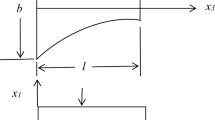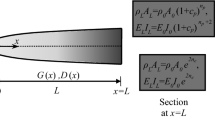Abstract
Purpose
In this work, a new numerical modeling is proposed to demonstrate vibration behavior of an axially functionally graded piezoelectric material (AFGPM) beam. The effective material constants are supposed to have an axial variation in accordance with power law and exponential law distributions. The beam is actuated using the piezoelectric shear effect.
Methods
The Hamilton principle is employed to derive the equations of motion and boundary conditions. The generalized differential quadrature technique is used to convert available partial differential equations into linear algebraic form. The MATLAB code is developed to solve the linear algebraic equations. The natural frequencies are compared with the natural frequencies obtained in previous published work for reduce case.
Results
The effects of slenderness ratios, volume fraction indices, boundary conditions and exponent parameters on the natural frequencies of the AFGPM beam are reported.
Conclusions
It can be observed that the natural frequency decreases with increase in volume fraction index under both clamped-clamped (C-C) and clamped-free (C-F) boundary conditions. With the increase of length of the beam, the natural frequency decreases under both clamped-clamped (C-C) and clamped-free (C-F) boundary conditions. The clamped-clamped AFGPM beam has large frequency as compared to the natural frequency of clamped-free AFGPM beam. The above observations are made for the AFGPM beam where the material properties are varied along the axial direction according to the power law. Next, the observations are made for the AFGPM beam where the material properties are varied in the axial direction according to an exponential law. It can be seen that the natural frequency decreases with an increase in the exponent parameter from -1 to 0 for all slenderness ratios. When the exponent parameter is further increases from 0 to 1, the natural frequency increases under clamped-clamped boundary condition. While, the natural frequency decreases continuously with the increase of the exponent parameters under clamped-free boundary condition.












Similar content being viewed by others
References
Liu B, Chen H, Cao W (2019) A novel method for tailoring elasticity distributions of functionally graded porous materials. Int J Mech Sci 1(157):457–470
Su Z, Jin G, Ye T (2018) Electro-mechanical vibration characteristics of functionally graded piezoelectric plates with general boundary conditions. Int J Mech Sci 1(138):42–53
Wu CCM, Kahn M, Moy W (1996) Piezoelectric ceramic with functional gradients: a new application in material design. J Am Ceram Soc 79:809–812
Almajid A, Taya M, Takagi K, Li JF, Watanabe R (2002) Fabrication and modeling of porous FGM piezoelectric actuators. Smart Mater Struct 4701:467–476
Rubio WM, Vatanabe SL, Paulino GH, Silva EC (2011) Functionally graded piezoelectric material systems–a multiphysics perspective. Adv Comput Mater Model Class Multi-Scale Tech. 2011:301–39
Chi SH, Chung YL (2006) Mechanical behavior of functionally graded material plates under transverse load—Part I: analysis. Int J Solids Struct 43(13):3657–3674
Benjeddou A, Trindade MA, Ohayon R (1997) A unified beam finite element model for extension and shear piezoelectric actuation mechanisms. J Intell Mater Syst Struct 8:1012–1025
Sun CT, Zhang XD (1995) Use of thickness-shear mode in adaptive sandwich structures. Smart Mater Struct 4:202–206
Trindade MA, Benjeddou A, Ohayon R (1999) Parametric analysis of the vibration control of sandwich beams through shear-based piezoelectric actuation. J Intell Mater Syst Struct 10:377–385
Aldraihem OJ, Khdeir AA (2000) Smart beams with extension and thickness-shear piezoelectric actuators. Smart Mater Struct 9:1–9
Li JF, Takagi K, Ono M, Pan W, Watanabe R, Almajid A, Taya M (2003) Fabrication and evaluation of porous piezoelectric ceramics and porosity-graded piezoelectric actuators. J Am Ceram Soc 86:1094–1098
Qiu J, Tani J, Ueno T, Morita T, Takahashi H, Du HJ (2003) Fabrication and high durability of functionally graded piezoelectric bending actuators. Smart Mater Struct 12:115–121
Takagi K, Li JF, Yokoyama S, Watanabe R (2003) Fabrication and evaluation of PZT/Pt piezoelectric composites and functionally graded actuators. J Eur Ceram Soc 23(10):1577–1583
Li T, Chen YH, Ma J (2005) Characterization of FGM mono-morph actuator fabricated using EPD. J Mater Sci 40:3601–3605
Shindo Y, Narita F, Mikami M, Saito F (2006) Nonlinear dynamic bending and domain wall motion in functionally graded piezoelectric actuators under AC electric fields: simulation and experiment. JSME Int J Ser A 49(2):188–194
Yang J, Xiang HJ (2007) Thermo-electro-mechanical characteristics of functionally graded piezoelectric actuators. Smart Mater Struct 16:784–797
Yang L, Zhifei S (2009) Free vibration of a functionally graded piezoelectric beam via state-space based differential quadrature. Compos Struct 87:257–264
Armin A, Behjat B, Abbasi M, Eslami MR (2010) Finite element analysis of functionally graded piezoelectric beams. Iran J Mech Eng (English) 11(1):45–72
Doroushi A, Akbarzadeh AH, Eslami MR (2010) Dynamic analysis of functionally graded piezoelectric material beam using the hybrid Fourier-Laplace transform method. In: ASME 2010 10th Biennial Conference on engineering systems design and analysis. American Society of Mechanical Engineers, pp. 475–483
Doroushi A, Eslami MR, Komeili A (2011) Vibration analysis and transient response of an FGPM beam under thermo-electro-mechanical loads using higher-order shear deformation theory. J Intell Mater Syst Struct 22:231–243
Yao RX, Shi ZF (2011) Steady-state forced vibration of functionally graded piezoelectric beams. J Intell Mater Syst Struct 22(8):769–779
Lezgy-Nazargah M, Vidal P, Polit O (2013) An efficient finite element model for static and dynamic analyses of functionally graded piezoelectric beams. Compos Struct 104:71–84
Komijani M, Kiani Y, Esfahani SE, Eslami MR (2013) Vibration of thermo-electrically post-buckled functionally graded piezoelectric beams. Compos Struct 98:143–152
Komijani M, Kiani Y, Eslami MR (2013) Non-linear thermoelectrical stability analysis of functionally graded piezoelectric material beams. J Intell Mater Syst Struct 24(4):399–410
Yang J, Kitipornchai S, Feng C (2015) Nonlinear vibration of PZT4/PZT-5H monomorph and bimorph beams with graded microstructures. Int J Struct Stab Dyn 15(07):1540015
Shegokar NL, Lal A (2014) Stochastic finite element nonlinear free vibration analysis of piezoelectric functionally graded materials beam subjected to thermo-piezoelectric loadings with material uncertainties. Meccanica 49(5):1039–1068
Komijani M, Reddy JN, Ferreira AJ (2014) Nonlinear stability and vibration of pre/post-buckled microstructure-dependent FGPM actuators. Meccanica 49(11):2729–2745
Komijani M, Gracie R (2016) Nonlinear thermo-electro-mechanical dynamic behavior of FGPM beams. Compos Struct 150:208–218
Li YS, Feng WJ, Cai ZY (2014) Bending and free vibration of functionally graded piezoelectric beam based on modified strain gradient theory. Compos Struct 115:41–50
Ebrahimi F, Salari E (2016) Analytical modeling of dynamic behavior of piezo-thermo-electrically affected sigmoid and power-law graded nanoscale beams. Appl Phys A 122(9):793
Ebrahimi F, Daman M (2017) Nonlocal thermo-electromechanical vibration analysis of smart curved FG piezoelectric Timoshenko nanobeam. Smart Struct Syst 20(3):351–368
Ebrahimi F, Fardshad RE (2018) Modeling the size effect on vibration characteristics of functionally graded piezoelectric nanobeams based on Reddy’s shear deformation beam theory. Adv Nano Res 6(2):113
Maruani J, Bruant I, Pablo F, Gallimard L (2017) A numerical efficiency study on the active vibration control for a FGPM beam. Compos Struct 15(182):478–486
Heshmati M, Amini Y (2019) A comprehensive study on the functionally graded piezoelectric energy harvesting from vibrations of a graded beam under travelling multi-oscillators. Appl Math Model 1(66):344–361
Derayatifar M, Tahani M, Moeenfard H (2017) Nonlinear analysis of functionally graded piezoelectric energy harvesters. Compos Struct 15(182):199–208
Cai B, Zhou L (2019) A coupling electromechanical inhomogeneous cell-based smoothed finite element method for dynamic analysis of functionally graded piezoelectric beams. Adv Mater Sci Eng 6:2019
Chen M, Chen H, Ma X, Jin G, Ye T, Zhang Y, Liu Z (2018) The isogeometric free vibration and transient response of functionally graded piezoelectric curved beam with elastic restraints. Res Phys 1(11):712–725
Fatehi P, Farid M (2019) Piezoelectric energy harvesting from nonlinear vibrations of functionally graded beams: finite-element approach. J Eng Mech 145(1):04018116
Chu L, Li Y, Dui G (2020) Nonlinear analysis of functionally graded flexoelectric nanoscale energy harvesters. Int J Mech Sci 1(167):105282
Hajheidari P, Stiharu I, Bhat R (2020) Performance of non-uniform functionally graded piezoelectric energy harvester beams. J Intell Mater Syst Struct 12:1045389X20930083
Jing HX, He XT, Du DW, Peng DD, Sun JY (2020) Vibration analysis of piezoelectric cantilever beams with bimodular functionally-graded properties. Appl Sci 10(16):5557
Amini Y, Emdad H, Farid M (2015) Finite element modeling of functionally graded piezoelectric harvesters. Compos Struct 1(129):165–176
Parashar SK, DasGupta A, Wagner UV, Hagedorn P (2005) Nonlinear shear vibrations of piezoceramic actuators. Int J Non-Linear Mech 40(4):429–443
Parashar SK, Wagner UV, Hagedorn P (2004) A modified Timoshenko beam theory for nonlinear shear-induced flexural vibrations of piezoceramic continua. Nonlinear Dyn 37:181–205
Wang Q, Quek ST (2000) Flexural vibration analysis of sandwich beam coupled with piezoelectric actuator. Smart Mater Struct 9:103–109
Parashar SK, Wagner UV, Hagedorn P (2005) Nonlinear shear-induced flexural vibrations of piezoceramic actuators: experiments and modeling. J Sound Vib 285:989–1014
Sharma P (2019) Vibration analysis of functionally graded piezoelectric actuators. Springer, New York, NY
Parashar SK, Sharma P (2016) Modal analysis of shear-induced flexural vibration of FGPM beam using generalized differential quadrature method. Compos Struct 1(139):222–232
Sharma P, Parashar SK (2016) Free vibration analysis of shear-induced flexural vibration of FGPM annular plate using generalized differential quadrature method. Compos Struct 1(155):213–222
Sharma P (2018) Efficacy of harmonic differential quadrature method to vibration analysis of FGPM beam. Compos Struct 1(189):107–116
Sharma P, Parashar SK (2016) Exact analytical solution of shear-induced flexural vibration of functionally graded piezoelectric beam. In: AIP conference proceedings, vol 1728, No. 1, AIP Publishing LLC, p 020167
Singh R, Sharma P (2021) Vibration analysis of an axially functionally graded material non-prismatic beam under axial thermal variation in humid environment. J Vib Control 9:10775463211037150
Sharma P, Singh R, Hussain M (2020) On modal analysis of axially functionally graded material beam under hygrothermal effect. Proc Inst Mech Eng C J Mech Eng Sci 234(5):1085–1101
Bellman R, Kashef BG, Casti J (1972) Differential quadrature: a technique for the rapid solution of nonlinear partial differential equations. J Comput Phys 10(1):40–52
Bert CW, Malik M. Differential quadrature method in computational mechanics: a review.
Shu C (2012) Differential quadrature and its application in engineering. Springer Science & Business Media
Rajasekaran S, Tochaei EN (2014) Free vibration analysis of axially functionally graded tapered Timoshenko beams using differential transformation element method and differential quadrature element method of lowest-order. Meccanica 49(4):995–1009
Zhao Y, Huang Y, Guo M (2017) A novel approach for free vibration of axially functionally graded beams with non-uniform cross-section based on Chebyshev polynomials theory. Compos Struct 15(168):277–284
Funding
The authors received no financial support for the research, authorship, and/or publication of this article.
Author information
Authors and Affiliations
Corresponding author
Ethics declarations
Conflict of interest
The authors declared no potential conflicts of interest with respect to the research, authorship, and/or publication of this article.
Additional information
Publisher's Note
Springer Nature remains neutral with regard to jurisdictional claims in published maps and institutional affiliations.
Rights and permissions
About this article
Cite this article
Gupta, B., Sharma, P. & Rathore, S.K. A New Numerical Modeling of an Axially Functionally Graded Piezoelectric Beam. J. Vib. Eng. Technol. 10, 3191–3206 (2022). https://doi.org/10.1007/s42417-022-00550-8
Received:
Revised:
Accepted:
Published:
Issue Date:
DOI: https://doi.org/10.1007/s42417-022-00550-8




